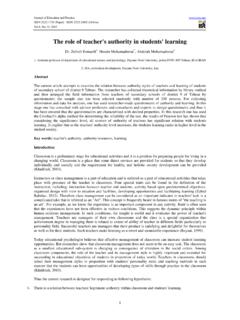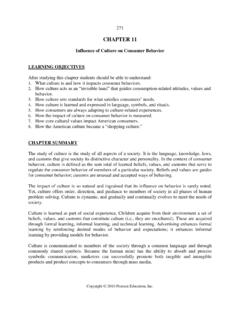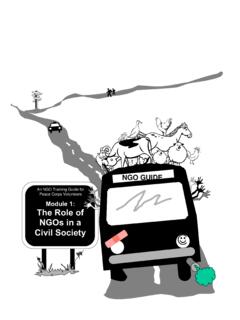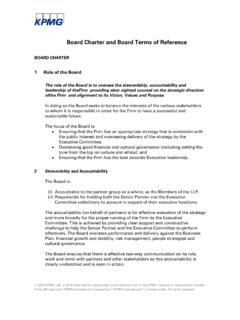Transcription of 9 and Nongovernmental Role of Governments Organizations
1 2149 Role of Governments and Nongovernmental Organizations Chapter Overview _____This chapter presents the role of Governments and NGOs in promoting sus-tainability. We start with the role of Governments in advancing sustainability and provide some examples of legislation along with the role of the EPA. Next, we segue into the history and the growth of NGOs and the role of NGO funding as it relates to power. We discuss the role of NGOs in social development, community development, and sustainable development and present cases of partnerships between NGOs and businesses. We conclude with a detailed discussion on a specific category of NGOs: the environmen-tal Nongovernmental Organizations (ENGOs).
2 By the end of this chapter, you should be able to do the following: Understand the role of Governments in promoting sustainability Present the role of the Environmental Protection Agency (EPA). Explain Agenda 21 and the role of local Governments . Discuss the history, growth, and funding of Nongovernmental Organizations (NGOs). Expand on the role of NGOs in social development, community develop-ment, and sustainable development. Explore NGOs and business partnerships. Discuss the role of NGOs and sustainable consumption. Present the five types of environmental OBJECTIVESC hapter 9 Role of Governments and Nongovernmental Organizations 215_____Role of GovernmentsWhat role, if any, should Governments play in promoting sustainability?
3 Governments worldwide are beginning to recognize the challenge of sustain-ability, and this term is being addressed in public policy discussions. Any one government cannot work in this area alone; it is imperative to work with other Governments in order to address the issue in a global context. According to a GlobeScan poll of experts, the leading role in achieving sus-tainability will be played by business (35%), followed by NGOs (30%), and Governments (24%) (Bell, 2002). Chapter 8 discussed the role of business in advancing sustainability, and this chapter will discuss the role of govern-ments and NGOs in advancing sustainability. Governments need to be able to anticipate rising demand for sustainable products and services.
4 Governments can play a key role in aiding the transi-tion toward more efficient, less damaging economies. Those Governments that can lead in this role would be able to set the agenda for their economies, industries, and citizens (Peck & Gibson, 2002). In most developed countries, like the United States and Canada, the gov-ernment is the largest employer, the largest landowner, and the largest fleet owner. The government is also the largest consumer of energy and has the largest impact on the environment. It stands to reason that Governments should incorporate sustainability principles in their internal operations (Bell, 2002).In developing countries, the role of the government assumes even greater significance.
5 Within the realm of sustainability, the Governments ought to encourage companies to address the needs of the world s entire population (Prahalad & Hart, 2002).According to a KPMG report, the government has four distinct roles in addressing sustainability concerns. These roles are as follows: 1. Policy development 2. Regulation 3. Facilitation 4. Internal sustainability managementAs shown in Figure , each of the policy making, regulating, facili-tating, and internal sustainability managing roles of government has its own characteristics and success factors. Combined, these roles have the potential to effectively support sustainability management through setting goals, driving change, and leading by example ( Sustainable Insight, 2009).
6 216 PART III STAKEHOLDER INTEREST AND CHOICESGOVERNMENT roles IN SUSTAINABILITYPOLICY DEVELOPMENTD evelopment of new policies to steer and enable sustainability innovationFACILITATIONC ooperation with business, society and public sector in order to achieve sustainability policy objectivesCharacteristics Boundaries are set by recognition of major sustainability challenges at global, national, regional and/or local levels Used to prioritize, set goals and design coherent long-term strategies Formulate targets and determine type of government activities and budget Characteristics Boundaries are set by political paradigms and ability and willingness of busi-ness and other actors to cooperate for change Used to stimulate breakthroughs in transition management R&D, endorsing, convening roles , financial incentives, societal cost benefit managementCriteria for success Focus on the most relevant and difficult issues from a long term perspective Define coherent and integrated strategies Formulate realistic goals (whose realization government is actually able to influence)
7 Criteria for success Align with other government sectors and agencies and with other roles in enhancing sustainability Set clear criteria for government initiative and the methods used in each phase of transition Pull out whenever possible to create breakthroughs in new transitionsExamples 20% reduction in emissions, share of renewable energy use 20% of total, overall cut of 20% in energy use by 2020 (EU) Millennium Development Goals (UN)Examples Covenant of Mayors (>400 EU Mayors) Green New Deal (USA)REGULATIONAll government initiatives in legislation, administration and enforcementSUSTAINABILITY MANAGEMENT WITH GOVERNMENT (CSR)The corporate social responsibility of each government body as an economic actorCharacteristics Boundaries set by (international) law Used to protect public benefit and to correct market failure in managing externalities Long term response to market (as it takes time to decide upon and implement new legislation)Characteristics Boundaries set by peer group, core values and stakeholders Used to lead by example and manage effects of core business Reduce carbon footprint, green procurement, manage supply chainCriteria for success Low administrative burden for government, business and consumers Sufficient (financial)
8 Incentives and controls to guarantee and enforce new legislationCriteria for success Work principle based instead of rule based, use stakeholder dialogue and be transparent Avoid greenwashing Create sufficient leverage to have a real impact on core businessExamples Emission Trading Schemes of NO2 and CO2 (European Union and EU member states) Regulation of supply chain management ( REACH, WEEE, EuP, RoHS) Environmental Impact Assessment ( CEQA, The California Environmental Quality Act)Examples Governments will have to meet the goal of 100% green procurement in 2010 (The Netherlands) European Green Capital (Stockholm 2010, Hamburg 2011) Sustainable city pillar of Rotterdam Climate Initiative (The Netherlands)PolicyRegulationFacilitation CSRSet goalsDrivechangeLead byexampleChanging Role of GovernmentsIncreasingly, Governments are called to form partnerships ranging from the ones with other levels of government to ones with civil society Organizations (CSOs) and the private sector.
9 In terms of advancing sustainability, the govern-ment can also play a significant role. The five roles are discussed as follows: 1. Vision/Goal setter: Governments need to provide vision and strategy to incorporate sustainability in public policy. Concepts such as natural capitalism (discussed in Chapter 6), eco-economy (Brown, 2009), and green economy (Milani, 2000) call for grand-scale transformations in systems dealing with energy, waste, water, and governance. Governments would need to develop strategies for a transition to an economy based on sustainability Four Government roles to Spur SustainabilitySource: Sustainable Insight (2009).Chapter 9 Role of Governments and Nongovernmental Organizations 217 2.
10 Leader by example: Governments can improve the environmental performance of public procurement (Organisation for Economic Co-operation and Development [OECD], 2002), whereby public funds are used in construction of highways and buildings, power generation, transportation, and water and sanitation services. Green procurement can also provide impetus to innovative and environmen-tally friendly products. As an example, Japan used procurement of low emission automobiles to drive innovation (Bell, 2002). 3. Facilitator: Governments need to create open, competitive, and rightly framed markets that would include pricing of goods and ser-vices, dismantling subsidies, and taxing waste and pollution, etc.















